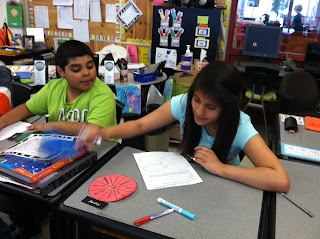My students are amazing...simply amazing! I am so impressed with the work they have been doing in literature circles.
Literature Circles can be really difficult to manage, organize, and keep straight. It seems that once all of that is done, it's even more difficult keeping students engaged with interesting conversation and activity. With much hard work and effort on their part, my students have really been running their own literature circles successfully. I rarely have to sit with groups for more than a few minutes at a time because they are able to generate interesting conversation among each other. They understand their roles and take them seriously, but most importantly they end up learning from each other based on the conversations they have. Here's what I just happened to listen in on today. (Because of the file size, I had to break it up into 3 videos.) In the third video, you can see the value of literature circles as one group member figures something out with the help of the others. I was so proud! If you're interested in how my students were able to get to this point, read on. Enjoy and way to go kiddos!
Students doing their literature circle jobs and having a conversation about the book Island of the Blue Dolphins.
This didn't just happen overnight. As you can see, the students have a lot of materials in front of them. First, I spent two weeks during shared reading using the same book to model six different roles that the students would be expected to do in their groups.
While completing their reading assignment, they complete a literature circle journal that requires them to analyze vocabulary words, summarize, ask questions, make predictions, infer, visualize, and think about an idea they'd like to share with their group. This along with the role cards are what they they use to guide their discussion.
After they've had about 10-15 minutes to discuss, they have the option to complete items from the literature circle activity set or play a literature circle game- both require more discussion and higher level thinking.
They stay on task for 45 minutes. It's amazing to have seen them come this far, and the best part is that they are enjoying their books and really working well together, and that's what it's about.
If you want to know more about these materials, just click on any of them.








